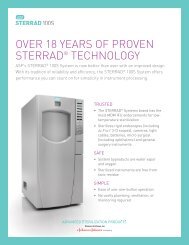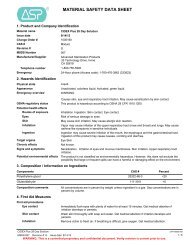CLEANASCOPE System Enhances Endoscope Transport & Handling
CLEANASCOPE System Enhances Endoscope Transport & Handling
CLEANASCOPE System Enhances Endoscope Transport & Handling
You also want an ePaper? Increase the reach of your titles
YUMPU automatically turns print PDFs into web optimized ePapers that Google loves.
“The liner system is one of the most important reasons why many facilities<br />
are adopting the <strong>CLEANASCOPE</strong> <strong>System</strong>—the color-coded liners take the<br />
guesswork out of endoscope reprocessing.”<br />
According to Thomson, the <strong>CLEANASCOPE</strong> <strong>System</strong><br />
quickly resolves endoscope transport problems. The<br />
closed, reusable transport trays, carts, and liner<br />
system reduce the risk of cross-contamination from<br />
droplet or airborne contaminants and allow secure<br />
transportation to and from decontamination rooms.<br />
“With the <strong>CLEANASCOPE</strong> trays and mobile cart,<br />
instruments are safely contained, and it is no longer<br />
necessary to carry around soiled equipment in open<br />
containers,” she said.<br />
Eliminating the Guesswork<br />
The <strong>CLEANASCOPE</strong> <strong>System</strong> helps ensure that patients<br />
are not inadvertently exposed to infection risks. The<br />
patented, single-use liner system offers a protective<br />
environment for a disinfected endoscope and provides<br />
clear identification for staff of whether the equipment<br />
is clean or contaminated. After a patient procedure,<br />
the endoscope is wiped down, flushed, and placed in a<br />
<strong>CLEANASCOPE</strong> tray. A red liner cover then is placed<br />
over the tray, ensuring that the endoscope can be<br />
Red & Green Liners Identify Clean<br />
Versus Contaminated <strong>Endoscope</strong>s,<br />
Improving Patient Safety<br />
The <strong>CLEANASCOPE</strong> <strong>System</strong>’s unique colored liners<br />
improve patient safety by signaling to staff whether an<br />
endoscope is clean or dirty. A contaminated endoscope<br />
is placed in a tray and covered with a red liner,<br />
indicating that it is contaminated. Once reprocessed,<br />
the endoscope is covered with a green liner, letting<br />
staff know that is safe to use.<br />
2<br />
Benefits of the<br />
<strong>CLEANASCOPE</strong><br />
Liner <strong>System</strong>:<br />
• Reduces risk<br />
of crosscontamination<br />
• Offers a protective<br />
environment for<br />
endoscopes<br />
• Provides clear<br />
identification<br />
of whether<br />
equipment is clean<br />
or contaminated<br />
• Protects patients<br />
and improves the<br />
efficiency of the<br />
reprocessing cycle<br />
safely and hygienically transported back to the cleaning<br />
room—and alerting staff members that the endoscope<br />
is contaminated. Once the endoscope is reprocessed,<br />
it is placed in a <strong>CLEANASCOPE</strong> tray, with a clean liner,<br />
and covered with a green liner cover, signaling to staff<br />
that it is safe to use for procedures. This unique<br />
liner system helps protect patients and improve the<br />
efficiency of the endoscope reprocessing cycle. (See<br />
Sidebar: Red & Green Liners Identify Clean Versus<br />
Contaminated <strong>Endoscope</strong>s, Improving Patient Safety)<br />
According to Thomson, it can be difficult to differentiate<br />
between clean and dirty endoscopes when a facility<br />
uses open containers. “Equipment can be placed in a<br />
receptacle that isn’t easily identifiable as being dirty,”<br />
she said. “In a busy endoscopy environment, there is<br />
the potential risk of someone picking up that scope<br />
and using it on another patient. Now with the<br />
<strong>CLEANASCOPE</strong> <strong>System</strong>, there is a fail-safe way of<br />
telling whether scopes are clean or dirty, and staff can<br />
make sure instruments are in the appropriate area—<br />
especially important in hectic endoscopy departments.”<br />
The <strong>CLEANASCOPE</strong> <strong>System</strong> also contributes to<br />
increased efficiency. “The ability to quickly, easily, and<br />
safely transport instruments from the procedure room<br />
to the decontamination area and back greatly improves<br />
efficiency,” she said.<br />
“The system works very well. Facilities can place<br />
carts near the endoscopy rooms stocked with clean<br />
endoscopes, and clinical staff members will know<br />
exactly where to go to find what they need. When a<br />
procedure is complete, scopes can be immediately<br />
transported in a covered, color-coded tray to the<br />
decontamination area. Everyone will know what they<br />
are doing, and people in the decontamination room<br />
can quickly see what needs to be cleaned. The liner<br />
system is one of the most important reasons why<br />
many facilities are adopting the <strong>CLEANASCOPE</strong><br />
<strong>System</strong>—the color-coded liners take the guesswork<br />
out of endoscope reprocessing.”<br />
Cutting Repair Costs<br />
Thomson said that another key feature of the<br />
<strong>CLEANASCOPE</strong> <strong>System</strong> is its reusable trays, which<br />
guard against costly equipment repairs by protecting<br />
endoscopes from accidental damage during transport.










